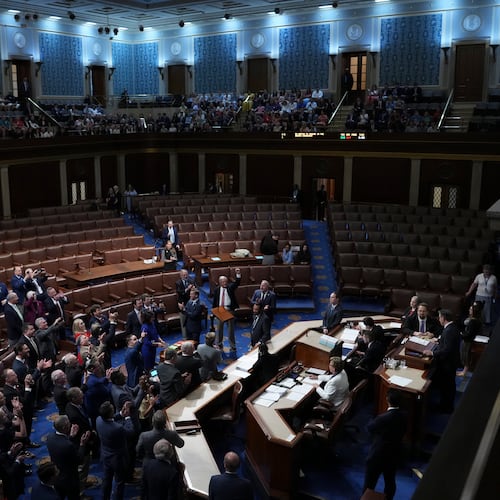The U.S. economy added another 252,000 jobs last month, dropping the unemployment rate to 5.6 percent, according to the Bureau of Labor Statistics. In addition, previous job-growth estimates for October and November proved to be too low, and were raised by a total of 50,000.
All in all, the U.S. economy added 2.95 million jobs in 2014, the largest annual increase since 1994. The number of Americans working part-time for economic reasons -- meaning they wanted but could not find full-time jobs -- dropped by 1.2 million. Since 2009, the economy has added 10.7 million jobs, the largest five-year increase since 1995-2000. Private-sector job growth has been even more impressive, jumping 11.2 million in the last five years.
Of course, to hear Sen. Mitch McConnell tell it, that five-year record of growth can be attributed to the fact that Republicans took control of the U.S. Senate a few days ago, an event so recent that it can't even be plotted on the chart above.
However, the news from the BLS was not entirely encouraging:
"In December, average hourly earnings for all employees on private nonfarm payrolls decreased by 5 cents to $24.57, following an increase of 6 cents in November. Over the year, average hourly earnings have risen by 1.7 percent. In December, average hourly earnings of private-sector production and nonsupervisory employees decreased by 6 cents to $20.68."
Think about that. The stock market is soaring. According to Bloomberg News, "CEO compensation at large U.S. companies was 204 times higher than the pay of workers on average in 2013, up 20 percent since 2009." And in the past 15 years, corporate after-tax profits have almost quadrupled over what were already record all-time highs.
Yet over that same 15-year time frame, the average wage of private-sector production and nonsupervisory employees has risen by a whopping $1.32 an hour, adjusted for inflation. Median household income, again adjusted for inflation, has fallen by $5,000. The share of our nation's economic output that ends up the paychecks of working people has also fallen significantly over that time frame, a trend that shows no sign of reversing.
The fact that such trends are continuing, even as the unemployment rate falls and the economy expands, ought to be troubling to most Americans. It seems to me that we have four basic choices on how to respond to it:
- Do nothing, writing off the trend as the inevitable, sancrosanct verdict of a supposedly free market. That also means accepting its debilitating impact on the middle class and on our political culture;
- Accept the trend as inevitable, but attempt to compensate for its impact on the vast majority of Americans through government programs;
- Recognize that the trends may not be the inevitable, sancrosanct verdict of a free market but instead may be the product of government policies that have favored the interests of capital over those of labor, and those of Wall Street over Main Street;
- Take the Republican approach, which argues that the trend is the result of government policies that have been insufficiently deferential to capital. Under that theory, tax cuts for the wealthy and corporations and reduced spending on social programs, from Medicaid to Social Security, will produce a more equitable outcome.
Which do you choose?
-------------
UPDATE:
For those conservatives who insist that the rapidly improving jobless rate has been driven by a decline in those Americans willing to work -- aka the labor participation rate -- well, we have a chart for that too:
As I mentioned in comments, that's actually a pretty strong performance if you consider that 10,000 Baby Boomers are dropping out of the job market each and every day as they reach retirement age:
10,000 retirees a day X 365 days = 3.65 million fewer Baby Boomers participating in the job market.
Yet despite that strong demographic trend, the overall participation rate hasn't changed.
About the Author
Keep Reading
The Latest
Featured


